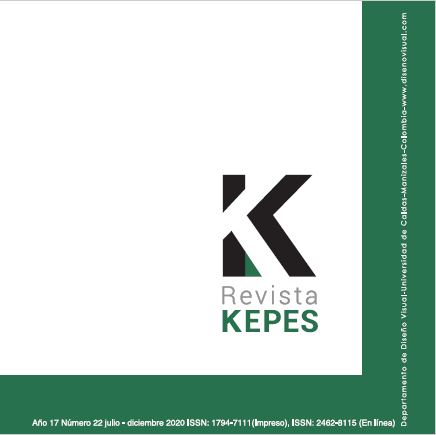Authors
Abstract
Unlike Melchionne (2013) and Naukkarinen (2013), I advocate an expansive definition of everyday aesthetics that, in addition to the most common and everyday experiences, includes festivals, tourism, and countless activities carried out daily by artists and professionals from various areas. Continuities between aesthetics of everyday life and the aesthetics of art and nature are established. For example, the act of looking through a window may involve aspects of all three aesthetics. Although I agree with Melchionne (2013) in that everyday aesthetics is closely linked to questions about the search for subjective well-being, I assume a more expansive approach based on recent psychological studies of the experience of “awe” to emphasize the importance of such experiences in subjective search, linking this way, the most outstanding aspects of everyday aesthetics, the aesthetics of art and the aesthetics of nature.
References
Berleant, A. (1964). The Sensuous and the Sensual in Aesthetics. Journal of Aesthetics and Art Criticism, 23(2), 185-192.
Burke, E. (1990). A Philosophical Enquiry into the Origin of our Ideas of the Sublime and Beautiful. New York: Oxford University Press.
Carlson, A. (1979). Appreciation and the Natural Environment. Journal of Aesthetics and Criticism, 37(3), 267-275.
Davies, S. (2015). The Artful Species. Oxford: Oxford University Press.
Dewey, J. (2005). Arts as Experience. New York: Perigree.
Dickie, G. (1971). Aesthetics: An introduction. Indianapolis: Pegasus, BobbsMerrill.
Dissanayake, E. (1992). Homo Aestheticus: Where Art Comes from and Why. New York: Free Press.
Dogen, E. (2007). Shobogenzo: The True Dharma-Eye Treasury. Volume I (Taisho Volume 82, Number 2582). (G.W. Nishijima & C. Cross, trds.). Bukkyo Dendo Kyokai and Nomata Center for Buddhist Translation. Recuperado de http://www.bdkamerica.org/digital/dBET_T2582_Shobogenzo1_2009.pdf
Dutton, D. (2010). The Art Instinct. New York: Bloomsbury Press. Fitzgerald, F. S. (2011). Winter Dreams. En Th. Fasano (Ed.), Great Short Stories by Great American Writers (pp. 382-399). Claremont: Coyote Canyon Press.
Haapala, A. (2005). On the aesthetics of everyday: familiarity, strangeness and the meaning of place. En A. Light & J.M. Smith (Eds.), The aesthetics of everyday life (pp.39-55). New York: Columbia University Press.
Hanh, T. N. (1987). The Miracle of Mindfulness (M. Ho, tr.). Boston: Beacon Press.
Irvin, S. (2008). The Pervasiveness of the Aesthetic in Ordinary Experience. ritish Journal of Aesthetics, 48, 29-44.
Kant, I. (2013). The Critique of Practical Reason (T. Kingsmill Abbot, tr.). Proyecto Gutenberg. Recuperado de http://www.gutenberg.org/ebooks/5683
Keltner, D. & Haidt, J. (2003). Approaching Awe, A Moral, Spiritual, And Aesthetic Emotion. Cognition and Emotion, 17, 297-314.
Leddy, T. (2012a). The extraordinary in the ordinary. Peterborough: Broadview Press.
Leddy, T. (2012b). Defending everyday aesthetics and the concept of pretty. Contemporary Aesthetics, 10. Recuperado de http://www.contempaesthetics.org/newvolume/pages/article.php?articleID=654&searchstr=leddy
Leddy, T. (2014). Everyday Aesthetics and Happiness. En L. Yuedi & C. Carter (Eds.), Aesthetics of Everyday Life: West and East (pp. 26-47). New Castle upon Tyne: Cambridge Scholars Publishing.
Lintott, S. (2012). The Sublimity of Getating and Giving Birth: Toward a Feminist Conception of the Sublime. En S. Lintott & M. Sander-Staudt (Eds.), Philosophical Inquiries into Pregnancy, Childbirth, and Mothering: Maternal Subjects (pp. 237-250). London: Routledge
Melchionne, K. (2013). The definition of everyday aesthetics. Contemporary Aesthetics, 11. Recuperado de http://www.contempaesthetics.org/ newvolume/pages/article.php?articleID=663 &searchstr=melchionne
Melchionne, K. (2014). The point of everyday aesthetics. Contemporary Aesthetics, 12. Recuperado de http://www.contempaesthetics.org/newvolume/pages/article.php?articleID=700&searchstr=melchionne
Mikulak, A. (2015). All about Awe: Science Explores How Life’s Small Marvels Elevate Cognition and Emotion. Observer, 28, 4. Recuperado de http://www.psychologicalscience.org/issue/april-15Moore, T. (1996). The ReEnchantment of Everyday Life. New York: Harper Collins.
Naukkarinen, O. (2013). What is “Everyday” in Everyday Aesthetics? Contemporary Aesthetics, 11. Recuperado de http://www.contempaesthetics.org/newvolume/pages/article.php?articleID=675
Piff, P. & Keltner, D. (2015, May 24). Why Do We Experience Awe? New York Times (Sunday Review), p. 10.
Plutchik, R. (s.f). Contrasting and Categorization of Emotions. En Wikipedia. Recuperado de https://en.wikipedia.org/wiki/Contrasting_and_categorization_of_emotions#Plutchik.27s_wheel_of_emotionsSaito, Y. (2010). Everyday Aesthetics. Oxford: Oxford University Press.
Shusterman, R. (2007). Asian Ars Erotica and the Question of Sexual Aesthetics. The Journal of Aesthetics and Art Criticism, 65, 55-68.
Shusterman, R. (2012). Thinking Through the Body: Essays on Somaesthetics. Cambridge: Cambridge University Press. Wilde, O. The Decay of Lying. Recuperado de http://virgil.org/dswo/courses/novel/wilde-lying.pdf

 pdf (Español (España))
pdf (Español (España))
 FLIP
FLIP






















